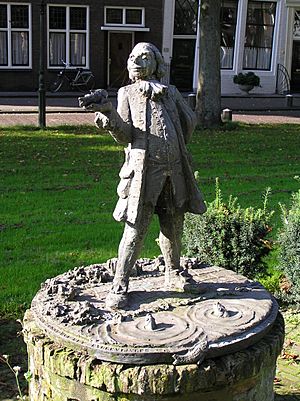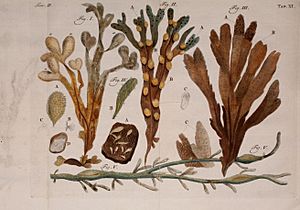Job Baster facts for kids
Job Baster (born April 2, 1711, in Zierikzee – died March 6, 1775) was a Dutch doctor and naturalist. He spent most of his life studying medicine and the natural world. He is known for his detailed observations of marine life and for introducing goldfish to the Netherlands.
Contents
Early Life and Studies
Job Baster studied medicine at Leiden University. In 1731, he earned his degree as a doctor. Famous professors like Herman Boerhaave taught him how to study science. They showed him how to observe nature carefully.
After his studies, Baster traveled to Paris and London. He visited hospitals and botanical gardens. There, he met important scientists like Philip Miller and Hans Sloane. Later, he returned to his hometown of Zierikzee and worked as a doctor.
A Respected Scientist
In 1738, Job Baster became a Fellow of the Royal Society in London. This is a very old and respected group of scientists. He was recommended by his former teachers, Boerhaave and Willem 'sGravesande.
Baster was a scientist who studied many different things. Besides being a doctor, he wrote articles about medicine, gardening, and sea creatures. These articles appeared in important science journals. He also wrote many letters to other leading biologists of his time. In the Netherlands, he became famous for bringing the goldfish (called Kin-Yu) to the country. He also translated a book about gardening by Philip Miller.
Discoveries in Marine Life
Natuurlyke Uitspanningen
In 1759, Job Baster published his most famous book. It was called Natuurlyke Uitspanningen. This means "Natural Pastimes" or "Natural Recreations." The book had several parts. It shared his observations about sea plants and sea insects.
In the first two parts of his book, Baster discussed a big question. Were the living things at the bottom of the sea animals, plants, or something in between? Carl Linnaeus, another famous scientist, thought they were "zoophytes." This meant "plant-animals." Baster had his own ideas about this. Another naturalist, John Ellis (naturalist), strongly disagreed with Baster's ideas.
Studying Sea Creatures
Even with disagreements, Baster kept working on his book. It was beautifully illustrated with drawings of marine animals from the Dutch coast. He was the first person to describe and draw the medusas of hydropolyps. These are small, bell-shaped sea creatures. He also described the eggs and young forms (larvae) of many types of mollusks. Mollusks are soft-bodied animals like snails and clams.
Sadly, in 1765, Baster had to stop his work on marine life. He was 53 years old and became blind in his left eye.



